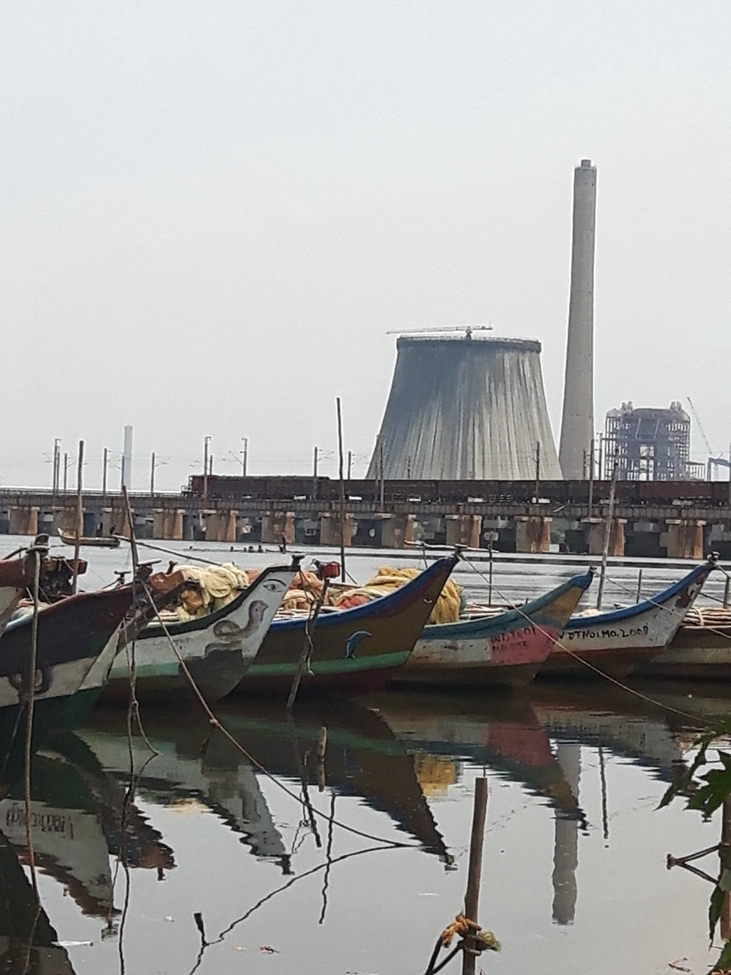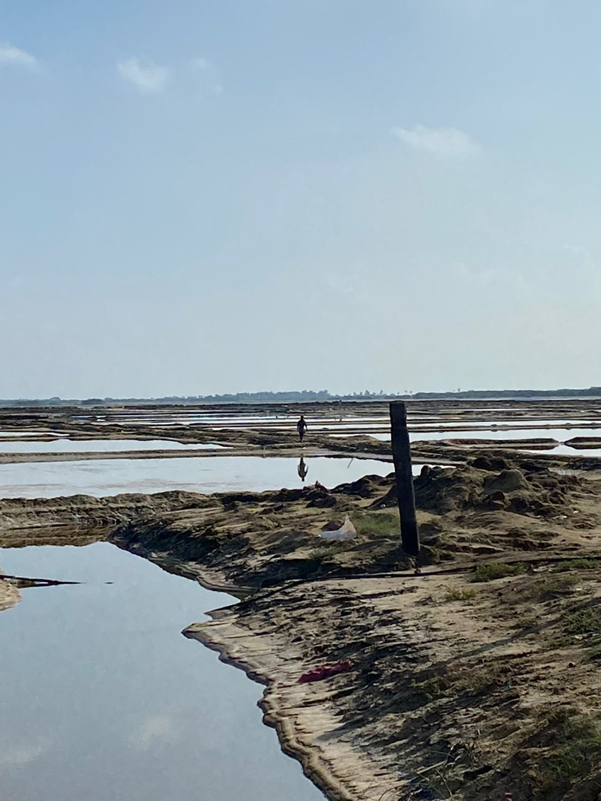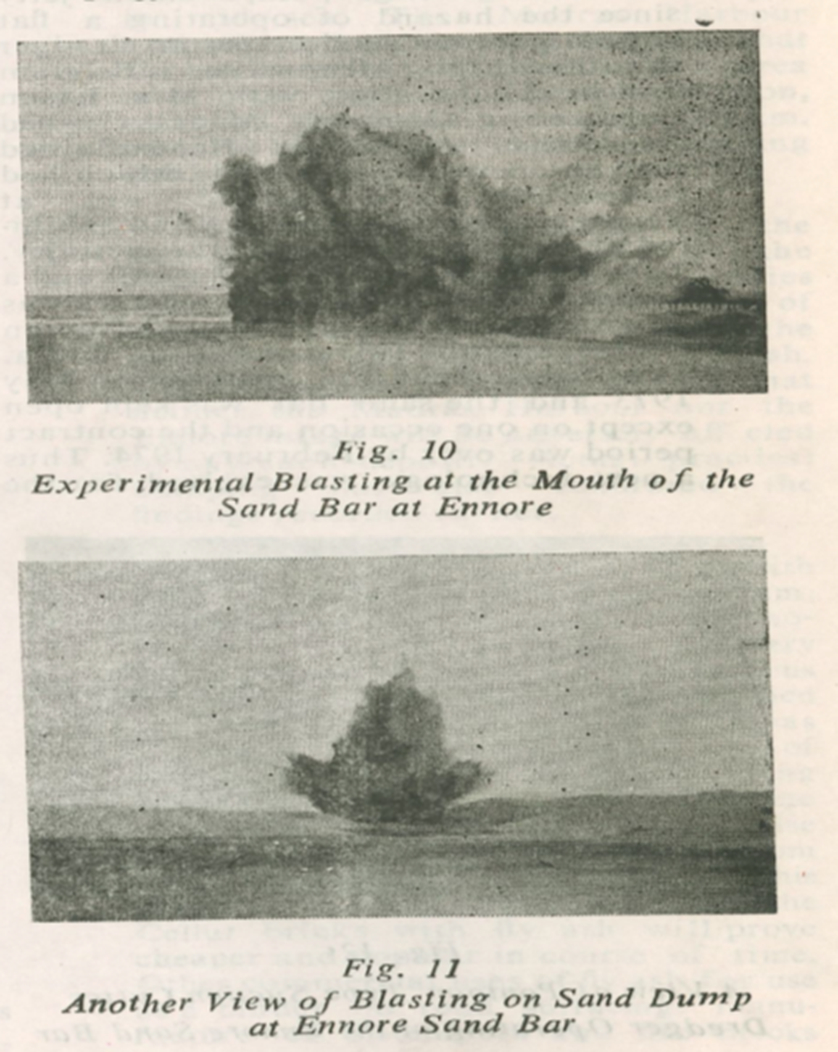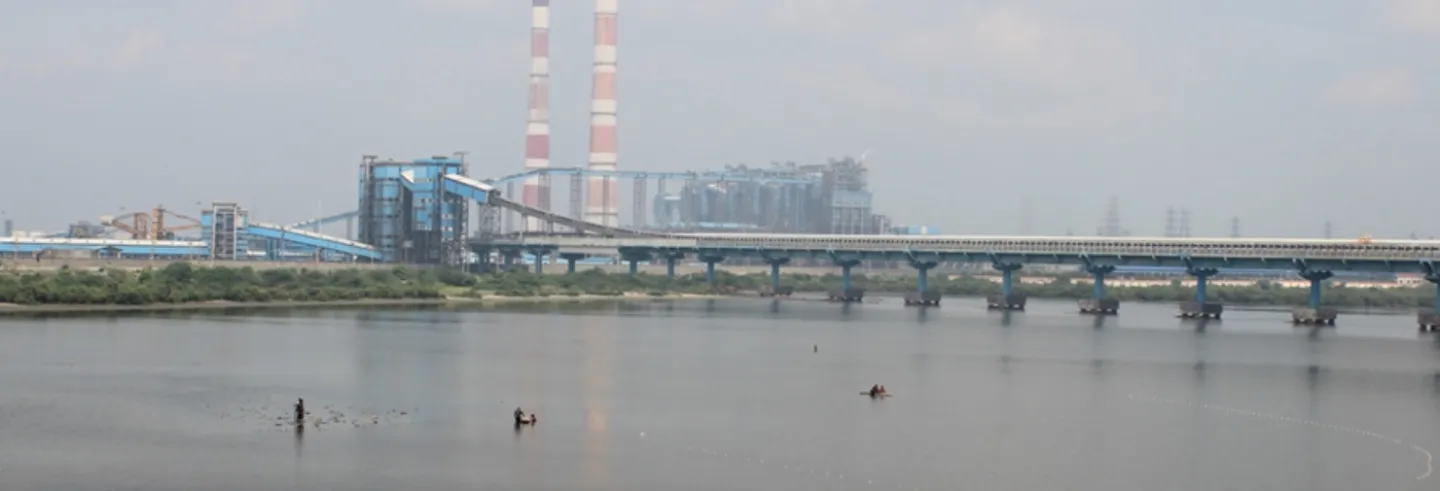On 4 December 2023, Cyclone Michuang flooded Chennai. Heavy rains disrupted daily life, crippled transport service, and plunged the city into darkness. To submerged residents, it was as if their harrowing experience of the floods of 2015 had come back.
Towards the north of the city, a second crisis unfolded.
Viscous oil from the state-run Chennai Petroleum Corporation's refinery ran through the Buckingham Canal and spilt into the Kortalaiyar river. Flood waters rapidly spread the oil into the Ennore estuary and to the sea, affecting over an estimated 20 square kilometres of coastal water and about twenty thousand residents of north Chennai.
The spill occurred in an ecologically rich inter-tidal meeting point of river, estuary, and sea that connects the Chennai’s aquifer system to the Coromandel coast’s Pulicat lake, India’s second-largest brackish water lagoon. This small section of watery confluence at Ennore set in a larger moving tapestry of water and land that alone supports thirteen settlements along it that, all combined, fish in the sea, the estuary, and the river. Zoom out and it is 40,000 people, if you include the settlements around Pulicat lake.
This is not the first time that Ennore has seen environmental disaster. Each blow takes it closer and closer to a permanent devastation.
The wetlands and marshes of Ennore are a living sponge that protects northern Chennai from drowning every monsoon. The leak suffocated this sponge, choking a rich aqueous web of life of spawning shellfish and fish, and delicate mangroves crucial for the marine ecosystem. The very tides that support a rich biodiversity crucial for marine spawn and mangroves keep bringing the oil back.
Amidst dying fish and a black sludge coating their nets and boats, the lives of Ennore’s fishing community, numbering in the thousands and for whom these waters are home, came to a complete standstill. To help them tide over the crisis, the Tamil Nadu government offered affected fishing families aid of Rs 12,500 and another Rs 10,000 to repair their boats. This is not a large sum of money for many fisher families, who have to service debt and for whom a regular ability to fish is a minimum requirement to survive.
Events like oil-spills appear as unfortunate accidents to be dealt by offers of monetary compensation. The historical record, however, shows that environmental accidents are not anomalies.
Indeed, this is not the first time that Ennore has seen environmental disaster. Each blow takes it closer and closer to a permanent devastation; each moment of rebuilding by its inhabitants is a testament to their sheer resilience.
The past and the present
Until the 1960s, the wetlands of Ennore supported a large salt industry of British colonial origin. Fishing thrived in the backwaters. The salt pans, in fact marshes, sustained a rich marine life, some farming, and a range of artisanal workers such as fishers, crabbers, grazers, basket weavers, salt makers, boat makers, and potters.
Today, petrochemical sites line Ennore's western edges, beyond which Chennai hungrily eats farmland, forest, and pasture and sucks its water. Towards the east, the coast hosts a looming container port that if extended, will swallow the area’s last remaining salt pans and marshes.
In between, Ennore is a hub of oil refining and thermal power production. The area abounds in industry with a high concentration of hazardous chemicals, ports, and coal yards. Almost all of them have shiny websites advertising their check lists of corporate social responsibility. In the meantime, ash slurry from Ennore’s two thermal power plant complexes regularly leak from trucks, pipes and ash dykes into the wetlands killing birds and fish and causing soaring rates of cancer and lung disease.

Ennore, in fact, is not a geographical margin. It rather offers a central vantage point from which to understand India’s inability to meaningfully discuss the ethics of its energy transition. Its history indicates why environmental harms caused by industry and fossil fuels elicit only contingent responses of compensation and hazard management.
Mananging agrarian democracy
The transformation of Ennore into an energy and chemical hub occurred in a relatively short span of six years between 1965 and 1971.
Global fossil fuel companies led the development, facilitating intergovernmental energy alliances and profiting from it. Chennai Petroleum, formerly known as Madras Refinery, was a joint venture between the government of India, Amoco (American Chemical and Oil Company, an oil refining behemoth founded by Standard Oil), and National Iranian Oil Company.
The conditions for these global alliances in Ennore were set in place by a crisis in energy and food and by fear of agrarian radicalism in India.
In 1966, the year just after it helped establish the Madras Refineries, Amoco partnered with the state-run Fertilizer Corporation of India to set up Madras Fertilizers in Manali. In the private sector, Coromandel International, then called Coromandel Fertilizers, was founded in the early 1960s by E.I.D Parry and the US-based International Minerals and Chemical and Chevron. Czechoslovakian technical expertise went into the Ennore Thermal Power Station, built by the state of Madras in the late 1960s. Among other things, the thermal power went into making the petrochemical industry’s chief product: fertiliser.
The conditions for these global alliances in Ennore were set in place by a crisis in energy and food and by fear of agrarian radicalism in India. In response to land-to-the tiller movements, the Green Revolution, a state-sponsored capitalist agricultural transformation was underway in the 1960s. Electricity and fertiliser production were stimulated by rapidly increasing farm acreage and new high yielding variety seeds, and in turn boosted petrochemical manufacture.
Thermal power allowed Madras to manage the complexity of an emergent and upwardly mobile agrarian democracy. Dams, Nehru’s temples of modern India, were subject to intense negotiation between the government and agrarian classes. A newly enfranchised agrarian population of dominant and upwardly mobile agrarian castes could effectively pressure the state and assert a powerful claim over hydroelectricity and riverine irrigation.
Bhaktavalsalam described Ennore as the safety net, and possibly the future.
In Madras, the chairman of the Electricity Board lamented how irrigation dominated the ways in which water was distributed and hydropower production was necessarily curtailed. V.P. Appadurai evoked a frustrated population: farmers unable to run pumps, industries struggling for power and even the film industry – so important to entertainment and of course Tamil Nadu's politics – could not produce blockbusters.
Furthermore, these years in the 1960s were a time of monsoon failures. Water was scarce in Madras. Indeed the ‘thaneer sakthi’, or waterpower of the state, ‘however big or small’, was bound to fail occasionally, Chief Minister Minjur Bhaktavalsalam argued. In his speech, published in the Electricity Board’s journal, Bhaktavalsalam described Ennore as the safety net, and possibly the future if the state could import and produce sufficient power using coal. He repeatedly used the term apivruti – development’ For the chief minister, the inauguration of the power plant was closely connected to agrarian development in the state.
The thermal power plant was presented as inevitable, and a march towards history.
Thermal power was also an infrastructural move to the coast.
The government picked Ennore as an ideal location for a power plant primarily because it had easy access to Madras’s growing industrial areas, its port, and to a small harbour, but it was not an agricultural hub. Coal, which Madras severely lacked, could be brought in with relative ease by ship and rail.
Having the sea nearby also meant that salt water would be available for cooling the plant. Ash and slag, elements that fossil fuel plants would reject, could be dumped in the sea. Tacitly, then, the decision to locate the power plant in Ennore acknowledged that fossil fuel and thermal power production would impact the kuppams, coastal hamlets.
A toxic tour
The knowledge of this systematic nature of environmental crimes in Ennore is carried in local memory. To visitors, the area’s residents offer a toxic tour.
While the rest of the city awaits the rains to slake its thirst, in Ennore, locals steel themselves for spikes in pollution.
When we visited the area regularly over a period of eight months from January to August 2023, a local auto driver ferrying us from the station pointed out where the tides had deposited the slick caused by two colliding oil tankers in 2017. It had lingered in the area for four years, well after ‘clean up.’ Fishers recall to journalists how in the 1990s, they built with their bare hands a barricade and trench across the canal to stem an oil leak.
While the rest of the city awaits the rains to slake its thirst, in Ennore, locals steel themselves for spikes in pollution as companies regularly release toxic gases and effluents under the cover of raging storms.
Such memories are recounted along with observations about the dearth of birds, the disappearance of marine species and other points of interest such as the countless shrines and tombs of gods, goddesses, Siddhars, Sufis, and other healers, who are venerated for protection from harm. This time, however, the prospect of healing stretches into the distant horizon, even in the most optimistic scenarios.
Remaking the coast
For the officials and middle classes who did not live in Ennore, it was empty coastal land and a backwater where salt workers toiled.

In reality, a thriving coastal economy hummed. Salt manufacture both during British rule and the early years of independent India had attracted workers and investment. Dense water and rail transport connectivity came up. The Buckingham Canal, a famine work-for-food project, yoked this coastal industry and infrastructure to the inland waterways and a regional hinterland.
The infrastructure of canals and waterways brought up a fishing industry of cooling stations, fish curing yards, and fishing settlements, preserving and carrying fish to Chennai. Estuarine fishing and canal fishing also thrived, intensifying kinship ties amongst artisanal inland and estuarine fishing groups up and down the coast from Pulicat to Cuddalore.
In the 1960s, the petrochemical and fossil fuel refinement complex reinvented Ennore by redrawing the relation between seawater, canal, and estuary.
Changes were afoot at a pace that had not previously been seen. A cooler plant was imported. Dredgers arrived. Stilts appeared as if from nowhere. Signs of construction were everywhere.
A rich visual archive of the Ennore power plant reveals the technological sublime transforming the sandy beach, the brackish lagoons, and backwaters.

On the day of inauguration of the thermal power plant, little of the landscape or the people of Ennore figured. The numerous speeches, including those by Chief Minister Bhaktavalsam and Electricity Board Chairman Appadurai, highlighted the vision of the shift from a focus on hydropower to fossil fuels to diversify energy production.
The exception was R. Venkatraman, the minister for industries, who unusually addressed the people of Ennore. He proclaimed the inauguration of the power plant as a ‘pleasant day’ for them. The Electricity Board’s journal reprinted his faith that: “The Ennore thermal station will not only add to the beauty but will also be an important addition to the industrial undertakings. The buzz of the machine not only generates feelings of aesthetic sense but also feelings of economic prosperity.”
Ennore transformed into a large thrumming machine. The opening of Madras Refinery, Madras Fertilizers, and the power plant turned Ennore’s air, wetlands, and especially its seawater into a machine-like infrastructure, a water-machine.
Coal and oil arrived from sea, sea water cooled the thermal power plant, and effluents made their way to the sea via the canal and estuary. The estuarine water, integral to salt making and fishing, now supported the production and refining of hydrocarbons. The rich inland fishing grounds waters at Ennore estuary were faced with the new force of thermal and industrial pollution.
The elements of change identified so cautiously by fishery scientists, have remained key arguments made by fishing communities in Ennore.
Fishers bore witness to this undiscussed but rapid transformation of Ennore into a water machine. Studies from marine biologists and ichthyologists confirmed, after consulting fishers, that dredgers that continuously patrolled the sandy bar of the Kortalaiyar (Kosasthalayar) river scared fish away from Ennore. Such attention to species and ecology is, of course, missing in the archives of the Madras Electricity Board. The elements of change identified so cautiously by fishery scientists, have remained key arguments made by fishing communities in Ennore then, as now, when reporting environmental harms and impacts on their way of life.
An intergenerational struggle
One of the worst affected settlements in December’s oil spill was Sivanpadaitheru, located at the ecologically rich inter-tidal meeting point. Its residents are inland fishers whose occupation is distinct, they fish in the backwaters, canals, and the river. Over the years, they have faced the brunt of toxic effluents released by Ennore’s chemical industry.
The problem is intergenerational.
Forty years ago, in 1972 just after the petrochemical complex was established, the president of Sivanpadaitheru Inland Fishermen Cooperative Society wrote a letter to the director of fisheries about the flow of effluents from the Manali refinery into the Kortalaiyar river and backwaters. That letter, now bound up in unpublished government records in the Tamilnadu State Archives, described how the fishers had lost their livelihoods and wanted the department to sanction compensation to each affected family. 1Tamil Nadu Forest and Fisheries Department Government Order No. 56 (Ms.), 28 September 1973 (Tamil Nadu State Archives, Chennai).
The 1972 petition was followed by several similar complaints by fisher village communities about the effluents. 2Tamil Nadu Forest and Fisheries Department Government Order No. 209 (Ms.), 15 November 1973; G.O. No. 231 (Ms.), 8 March 1975 (Tamil Nadu State Archives, Chennai). The Ennore panchayat president sought help for the village of Mugathwarakuppam, which was adversely affected by sand dredger operations at the power plant. The dredger noise had scared away fish. Kattukuppam too also been harmed by the dredgers and release of effluents from the Manali refinery.
These villages today seek to make visible their knowledge of how the creek and their way of life has been harmed, just as their elders had.
These complaints received from fisher panchayats and cooperative societies are the earliest testimony of pollution that defines Ennore’s struggles today.
There is no living memory of these early fisher protests from the 1970s in Ennore. However, their trace in the official archives compel us to consider how more recent mobilisations against the relentless toxic pollution in Ennore carry the past into the present as these villages today seek to make visible their knowledge of how the creek and their way of life has been harmed, just as their elders had. Livelihood is a term that is not only economics; it references a way of living, a way of thinking about relations to a place, to the seas and the season through work and culture.
The problem of the environmental fallout of fossil fuel refining and thermal power production was resolved temporarily, contingently.
Fisher testimony can be usefully contrasted with reports of engineers and other experts of the time. Reflecting on the reports that accompanied the establishment of oil refining and thermal power production in Ennore, it is hard to miss their support for the reinvention of Ennore as an energy geography that would power the state. They insisted that the environmental harms of thermal power production were uncertain.
In the absence of knowing for certain what the environmental impact could be, the reports advocated that, in the meantime, the building of the plants could continue and indeed was necessary to mitigate an unpredictable monsoon. The problem of the environmental fallout of fossil fuel refining and thermal power production was resolved temporarily, contingently, and entirely with compensation.
This is now established practice. A pipe now, a dump for a few years, a few days of compensation, repairing and replacing boats, so that power production can continue.
Conclusion
When we began writing this essay, the news of the oil spill made us wonder, what would it be like next time? Little did we realise that another leak would follow before we could finish writing.
On 26 December, news broke of an ammonia gas leak in Ennore from a damaged offshore pipeline. People from Periakuppam and Chinnakuppam gasped for breath, even as people from other villages and settlements panicked and ran for their lives. Many were admitted to hospital.
The ammonia arrives by sea and is transferred by a 2.5 km pipeline barely buried underneath the seabed to the factory of Coromandel International (formerly Coromandel Fertilizers). The factory is now temporarily closed. Ennore is in throes of protest, again.
One way to consider these protests is that they challenge an imagination that defers permanent solutions to environmental harms and prefers to focus on immediate and hence more contingent responses such as cleaning spills with bare hands, offering compensation to affected families, or corporate social responsibility.
Governing classes and techno-scientists turned to the coastal sea and its immediately adjacent waterways to support energy production. The sea appears as an engineering solution again and again.
In fact, as the protests show, this kind of contingent thinking is not that contingent at all. It is durable, even permanent. It relies again and again on an old colonial modernist imagination of the sea as an empty space.
The history of Ennore also illustrates how an economy driven by fossil fuel refining relies on an understanding of the sea as an unlimited receptacle of industrial waste for the planet. From the 1960s, in response to the uncertainties of electricity production caused by agrarian politics and unreliable monsoons in India, the governing classes and techno-scientists turned to the coastal sea and its immediately adjacent waterways to support energy production. The backwaters and the sea have since been treated a resource for cooling and carrying fossil fuels, and the wastes of refinement such as oily effluents, fly ash, and hot water.
The sea appears as an engineering solution again and again in Ennore’s infrastructure. It is treated as a liquid absent of life, of biota and species, including humans. This sense of the empty sea has transformed Ennore’s waterside and seaside ecologies and its stewards into collateral damage. It is completely antithetical to how coastal societies relate to the sea.
The Ennore mobilisation, in this sense, is part of an ongoing mobilisation of coastal societies across the Indian Ocean rim against marine pollution that remind us that water is not empty. And in that, perhaps, there is much to learn.
The authors wish to acknowledge the Reimagining the Good City from Ennore Creek, Chennai project funded by the British Academy.










